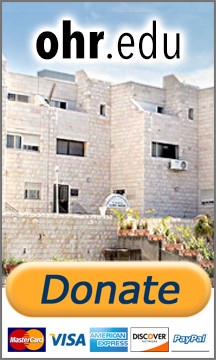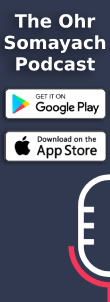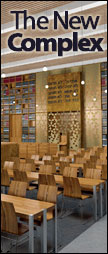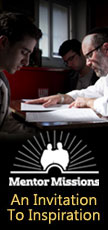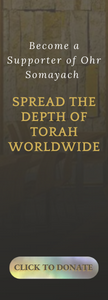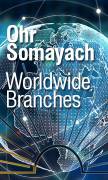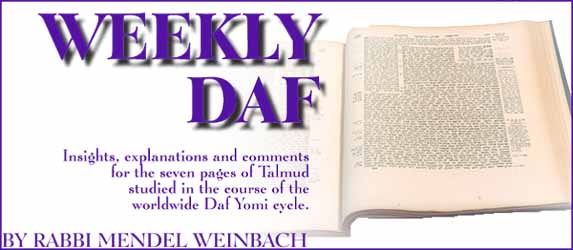Weekly Daf #103
Zevachim 23-29 -- Issue #103
8-14 Shevat 5756 / 29 January-4 February 1996
Rav Weinbach's insights, explanations and comments for the
7 pages of Talmud studied in the course of the worldwide Daf Yomi cycleA Leg to Stand On
The service of a kohen in the Beis Hamikdash is valid only if performed while he is standing directly on the floor of the Sanctuary.What if he has one foot on the floor and the other on either a vessel or a stone?
If that vessel or stone were removed and he would be capable of performing the service while standing on one leg then the service is valid; if not, it is invalid.
A comparable situation is described in last week's section of Zevachim (19b). A kohen must simultaneously have his hands and feet washed from the sacred basin before performing the services of the day in the Beis Hamikdash. One of the Sages interpreted this as requiring the kohen to place one hand upon the other and to put them upon his feet which have also been placed one upon the other. His view is rejected by the majority view because this washing is valid only if the kohen is standing, and since the position he legislates makes it impossible for the kohen to stand without support from a colleague, this is not considered standing.
Tosefos there already extends this rule to other situations such as reading the Torah for the congregation which must be done in standing fashion and would therefore prohibit the reader from leaning on something in such a fashion that if it were removed he would not remain standing. A little leaning would be permitted according to this reason. But Tosefos also cites the Talmud Yerushalmi which prohibits leaning as a lack of respect for the Torah and this would include leaning in any degree.
The problem of leaning extends as well to the Shmone Esrei prayer
which must be recited while standing and to the standing up we
do when a Sefer Torah passes in our view. It is the consensus
of the halachic authorities that in regard to respect for Torah
and for prayer we avoid leaning in any degree but if one's physical
condition requires him to lean he should at least make sure that
he does not lean to the point that if his support were removed
he would not remain standing.
Our Hour to Hour
What is the birthday of a korban (sacrificial animal)?
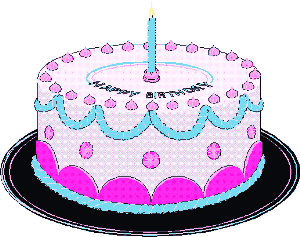 The lamb brought to the Beis Hamikdash on the fourteenth day of Nissan to be offered as a Korban Pesach must be less than a year
old. If it was born at 3 PM on Nissan 14 and all of its sacrificial
service was completed before 3 PM exactly a year later; or if
it was slaughtered at 3 PM exactly a year later but its blood
was only applied to the altar at 4 PM - do we consider it as already
being overaged and therefore disqualified?
The lamb brought to the Beis Hamikdash on the fourteenth day of Nissan to be offered as a Korban Pesach must be less than a year
old. If it was born at 3 PM on Nissan 14 and all of its sacrificial
service was completed before 3 PM exactly a year later; or if
it was slaughtered at 3 PM exactly a year later but its blood
was only applied to the altar at 4 PM - do we consider it as already
being overaged and therefore disqualified?
Should we compare the age of a korban to other matters with a fixed date of calculation such as the birthday of a Jewish king's reign which is fixed as the first of Tishrei regardless of when he began to reign, then this animal's first year would have ended on Tishrei and would have been considered overaged even if the entire service was completed before 3PM.
The Talmud in Mesechta Nidah (47b), however, cites scriptural proof that in regard to a korban, as in a number of other cases of calculating years, there is no fixed date and each animal's age is calculated according to when it was born. But not only do we calculate from day to day, but also from hour to hour, something we do not do in calculating when a boy becomes a Bar Mitzvah and we consider him as having reached maturity at the beginning of the eve of his thirteenth birthday even though 13 years of days and hours have not yet passed since his birth.
In our case, then, if the service was completed with the application
of the blood to the altar before 3PM it is a kosher korban, but
if the animal became an hour older than a year of days and hours
before the entire service is completed it is invalid.
General Editor: Rabbi Moshe Newman
Production Design: Lev Seltzer
HTML Design: Michael Treblow
© 1995 Ohr Somayach International - All rights reserved. This publication may be distributed to another person intact without prior permission. We also encourage you to include this material in other publications, such as synagogue newsletters. However, we ask that you contact us beforehand for permission, and then send us a sample issue.
This publication is available via E-Mail
Ohr Somayach Institutions is an international network of Yeshivot and outreach centers, with branches in North America, Europe, South Africa and South America. The Central Campus in Jerusalem provides a full range of educational services for over 685 full-time students. The Jewish Learning Exchange (JLE) of Ohr Somayach offers summer and winter programs in Israel that attract hundreds of university students from around the world for 3 to 8 weeks of study and touring.
 Copyright © 1995 Ohr Somayach International. Send us feedback.
Copyright © 1995 Ohr Somayach International. Send us feedback.Dedication opportunities are available for Weekly Daf. Please contact us for details.
